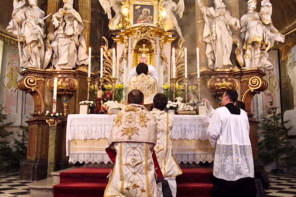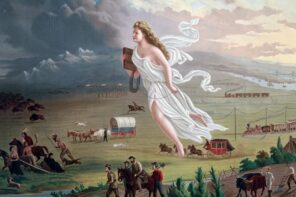In a recent opinion piece in the New York Times, fellow Catholic Ross Douthat criticized one of Pope Francis’ most consequential decisions: the July 16 motu proprio—or order—that reimposes restrictions on the Latin Mass preferred by many right-wing Catholics, thus reversing Pope Benedict XVI’s 2007 order.
Douthat is the most prominent American public intellectual critical of Francis’ pontificate but he’s certainly not alone in his criticism of the new restrictions. Still, Douthat’s argument merits a response because it reveals a particular cultural myopia unique to American Catholic conservatism.
Douthat argues that Catholicism has become “ungovernable” due to the swinging of the pendulum between popes of markedly different political persuasions since Vatican II. Douthat advances an interesting comparison between modern political history in the Western hemisphere and the last sixty years of the Catholic Church. He recasts the modern papacy as the political leadership after the end of the Ancien Regime: John Paul II as Napoleon, Benedict XVI as the Restoration, and Francis as “the 1848 revolution of the Catholic Church.” This is a fascinating narrative, which also happens to be deeply inadequate, false, and historically baseless, in at least two ways.
The first is the interpretation of the changes from Vatican II to the post-Vatican II period. Douthat doesn’t declare the deep roots and consequences of his way of representing contemporary, post-Vatican II Catholicism. The key assumption by Douthat, stated at the very opening of the article, is that “the church since the 1960s has been reliving the experience of France after 1789, with the arc of revolution and counterrevolution embodied in each successive pope.” This kind of comparison is very telling, because it repeats almost verbatim the interpretation of Vatican II by Marcel Lefebvre.
Lefebvre was a French archbishop who had served in colonial West Africa. During Vatican II he was one of the leaders of a minority deeply opposed to the reforms. After Vatican II he started a schismatic group, the Society of St. Pius X (sometimes referred to as SSPX). The illegal ordination of bishops by his group gained him excommunication in 1988, and still today the Society of St. Pius X is the most relevant anti-Vatican II group.
In his Open Letter to Confused Catholics (1986), Lefebvre described a chain of events from the Enlightenment to Vatican II: “The parallel I have drawn between the crisis in the Church and the French Revolution is not simply a metaphorical one. The influence of the philosophes of the eighteenth century, and of the upheaval that they produced in the world, has continued down to our times. Those who injected that poison admit it themselves.”
In the 21st century, American Catholicism has replaced French Catholicism as the hotbed of theological traditionalism. It therefore makes perfect sense that Douthat models his interpretation of the Catholic Church after French history, from the Revolution of 1789 to Napoleon and so on. But that’s not the only parallel between Lefebvre and Douthat’s interpretation of Vatican II and the liturgical reform recently defended by Pope Francis.
The rejection of the new liturgy and the defense of “the Mass of all times versus the Mass of our time” is the most well-known point of dissent between Lefebvre and his group and Vatican II supporters. Lefebvre took seriously the strong relationship between the liturgical constitution—i.e. the regulations regarding the Latin mass—and Vatican II as a whole, viewing it as the first irrevocable step towards the full implementation of Vatican II reforms. But the liturgical reform was only one element in Lefebvre’s much broader challenge to the theology of Vatican II.
One can say exactly the same about Douthat and that kind of neo-traditionalist Catholic culture in the U.S. The rejection of the liturgical reform of Vatican II is a way—if not the way—to reject Vatican II reforms on a wide range of issues, beginning with a certain understanding of the tradition and including the rejection of ecumenism, religious freedom (also for non-Catholics and non-Christians), and inter-religious dialogue.
The second problem with Douthat’s narrative is that he’s trying to squeeze the complex reality of the Catholic Church into a pre-set narrative—white, U.S.-centric, and politically conservative. Douthat writes:
“In the divisions of the church, the pressure toward traditionalist and progressive extremes, both Latin Massgoers and German Protestantizers recognize the fact of Catholic decline. Both believe the other’s vision would break the church in order to save it. Both have weaknesses and very different sorts of strength. The outcome of their struggle is—as good Catholics know—somehow foreordained.”
Douthat may be right about the clashing narratives regarding the fact of American Catholic decline. That Catholic world is in serious decline, despite the pathetic efforts of the restorationists to pretend we’re still in the 1950s, and despite the wishful thinking of old-guard American Catholic liberals who haven’t yet figured out why their children and students don’t share their concern for the church.
But reducing the dialectic of cultural and theological forces in contemporary Catholicism to “Latin Massgoers and German Protestantizers” is a caricature that wasn’t true even at the time of Vatican II. A conservative thinker like Douthat should know that the movement that prepared the theology of the liturgical reform at Vatican II in the 1920s and 1930s had clear features of conservative, anti-liberal, and even nationalist Catholicism—especially in Germany. The movement leading to the reform of the Mass at Vatican II proceeded from a rediscovery of the Fathers of the Church of the first centuries, but also from an anti-modern Catholic theology (e.g. Romano Guardini, one of the most important thinkers for Jorge Mario Bergoglio, a.k.a. Pope Francis). Who could have predicted that authentically “conservative” liturgical insights could have sparked the anti-Baroque, minimalist style of liturgy that eventually took over the 1970s in many places?
But leaving aside these historical-theological minutiae for a moment, Douthat is shockingly overlooking the most massive development in Catholicism today; that is, its globalization. The long game for the future of Catholicism is not in the hands of “Latin Massgoers and German Protestantizers,” but of Catholics in Latin America, Asia, and especially Africa. Douthat should also know that the globalization of Catholicism is happening in the West as well: U.S. Catholicism is no longer dominated by the concerns of white Catholics, and the same will soon have to be said for European Catholicism.
These are massive, historical forces which no pope—not even a Napoleon kind of pope—can stop. It’s a development that greatly complicates a certain narrative of the liberal interpretation of Vatican II as naturally shaping the future of the Church. But it should also say something to the revanchist sentiment against Vatican II which has recently found in right wing American politics a new source of ammunition.





